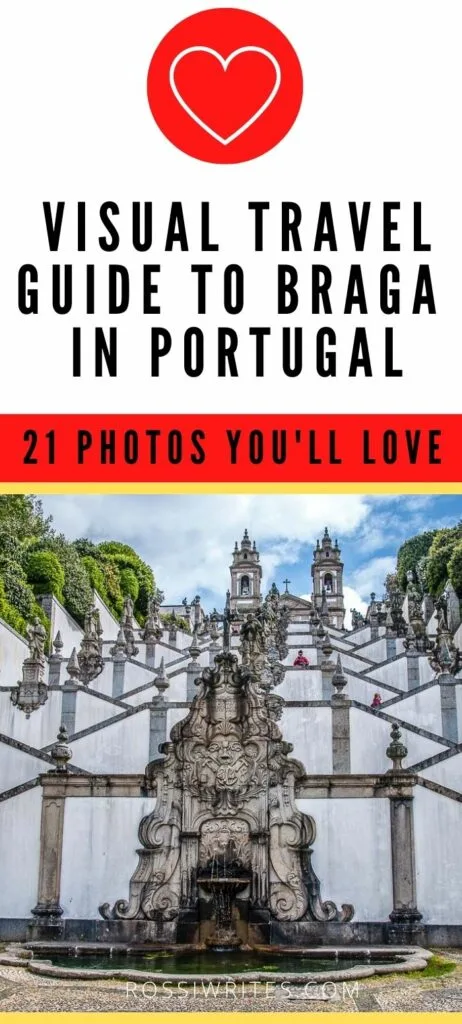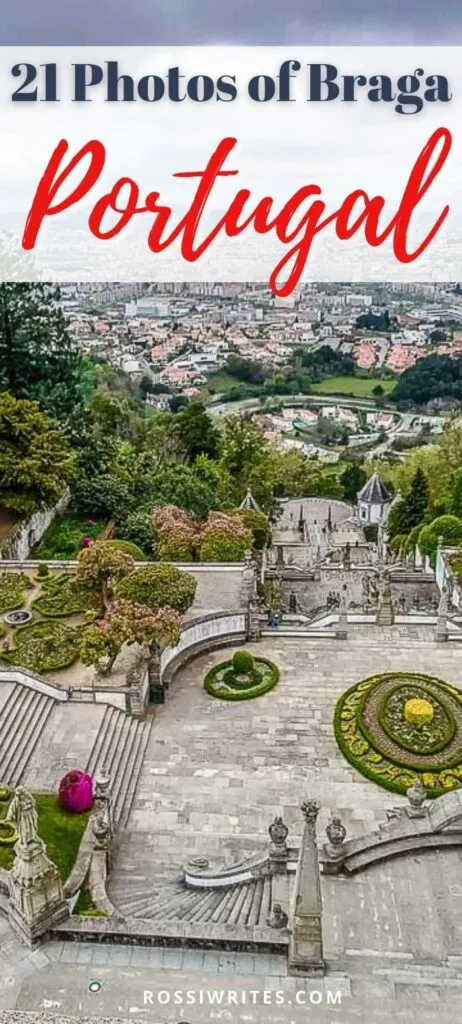Here are 21 photos of Braga in Portugal that build a visual travel guide to this beautiful city in the north of the country.
On account of its millennial history and important religious landmarks, Braga is known as the Portuguese Rome. The city also has the third-largest urban area in Portugal after the capital Lisbon and the city of Porto.
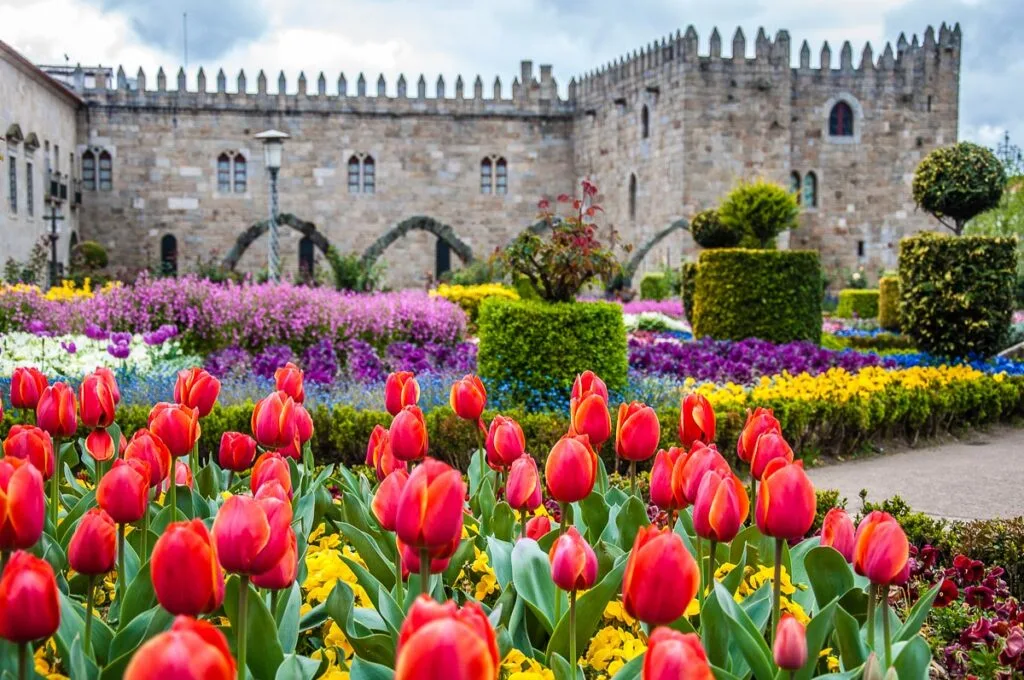
With a pretty historic centre and a long list of things to do, see, and enjoy, Braga is a great destination for an exciting day trip or a relaxing longer stay in this lush corner of the Iberian Peninsula.
An hour away from Porto – Portugal’s second-largest city – and with a direct railway connection to the Portuguese capital Lisbon and the University city of Coimbra, this is a place that must be seen in Europe. Especially, if you like exploring one-of-a-kind destinations that are often overlooked even though they are right next to the proverbial beaten track.
Braga is great to visit if you have an interest in history, authentic traditions, and fun events. Plus, this Portuguese city has several local dishes and pastries with delicious stories to tell.
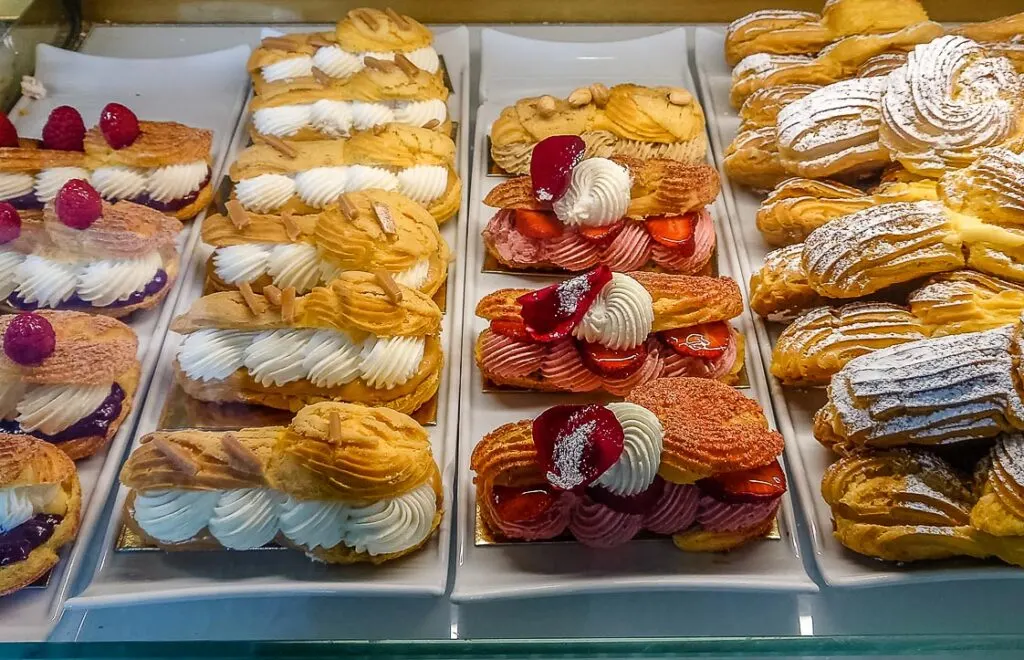
So, in this blog post today, I want to show you 21 photos of Braga to give you an idea of what this beautiful Portuguese city looks like. I will also share with you many curious tidbits to help you immerse yourself in its authentic atmosphere and little quirks.
Put together, they create a fun visual travel guide for Braga in Portugal. Scroll through it to see the city known as the Portuguese Rome for yourself. I hope that my photos and words will inspire you to put Braga high on your travel wish list for Portugal in particular and Europe as a whole.
Have a look!
Visual Travel Guide to Braga, Portugal – 21 Photos to Entice You to Visit the Portuguese Rome
Pin for Later!
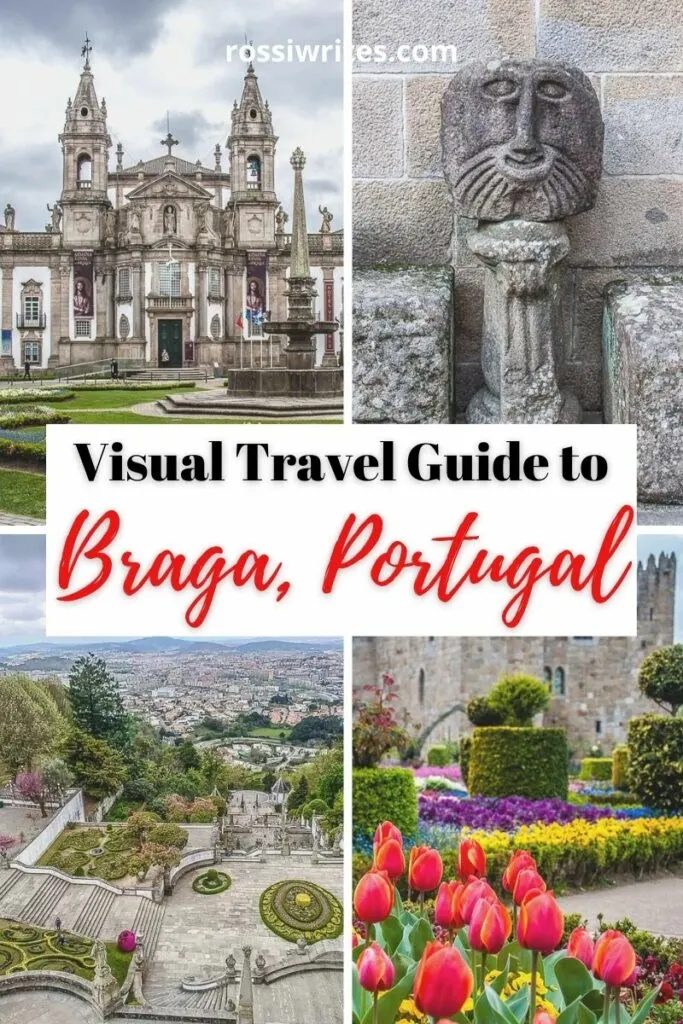
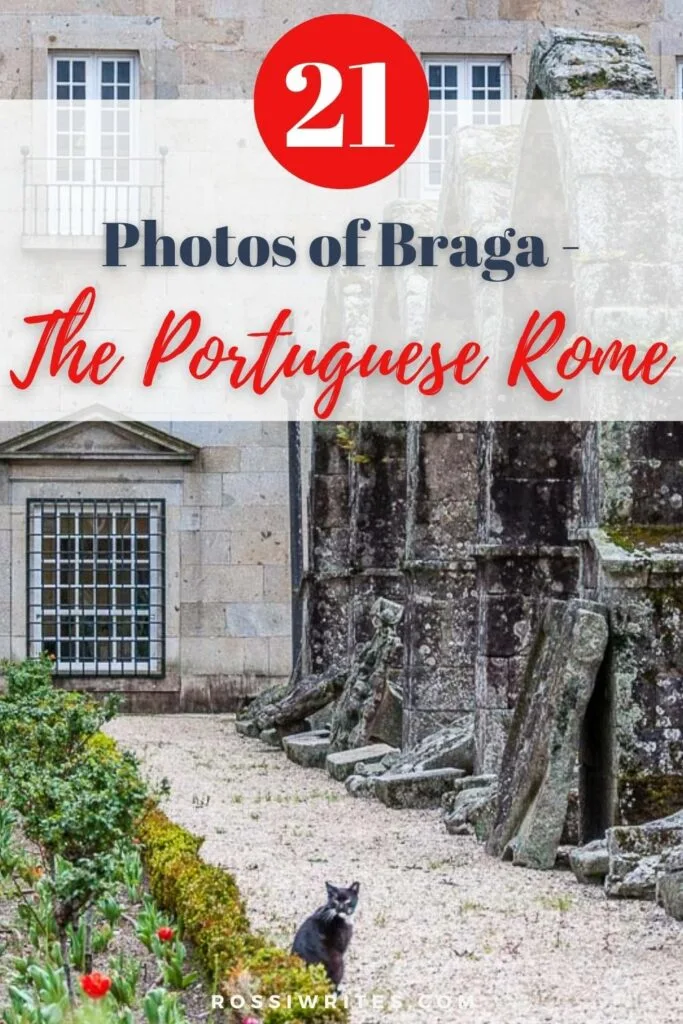
1. This is Braga in All Its Glory
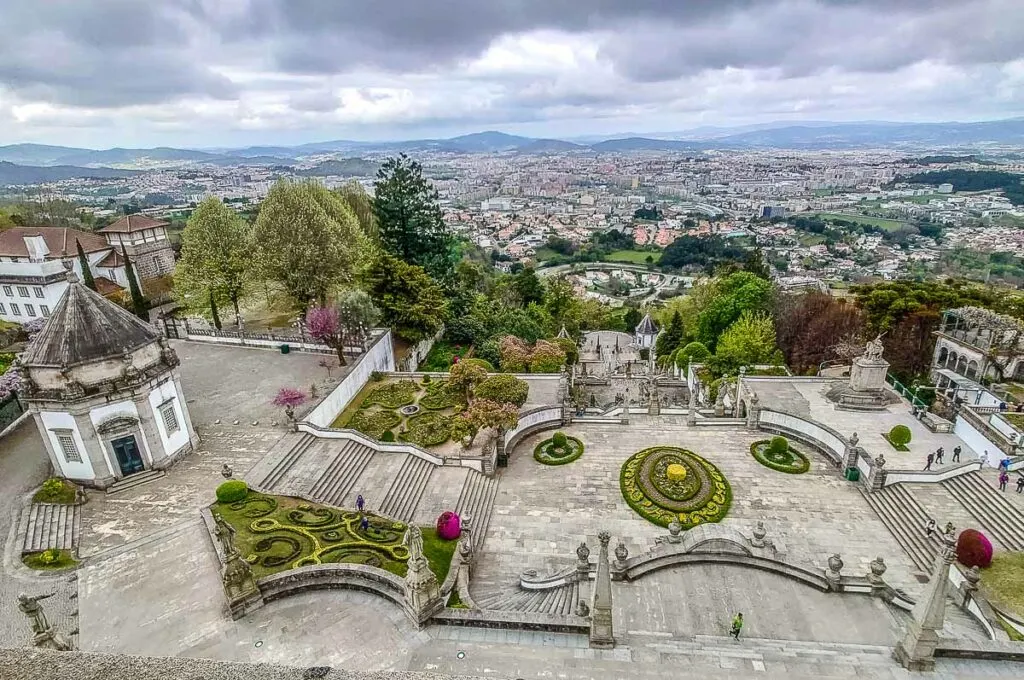
This is Braga – Portugal’s third-largest city in terms of its urban area. You will find it in the north of the country. It stands about an hour away from Porto – the second-largest Portuguese city – and only 20 mins or so away from Guimarães which is known as The Cradle of Portugal.
With a pretty historic centre dotted with important sights, Braga is a delight to visit and explore. It has a youthful spirit on account of hosting three of the campuses of the University of Minho. It also has a lot of ancient stories to tell, as this is a land that has been inhabited since times immemorial.
The best spot to see the whole of Braga for the first time is the top of Mount Espinho. This is a Sacred Mountain crowned by Bom Jesus do Monte – one of the most beautiful sanctuaries in Europe.
When you visit the sanctuary, you can scale the bell tower of its church to take in the panoramic views of Braga and the surrounding hills, plains, valleys, and mountains. Standing up there, next to the large bells that ring the time and invoke the faithful to prayer, your eyes can see all the way to the Atlantic Ocean on a clear day.
I took the above photo on a half-cloudy, half-sunny day in spring. Right beneath the bell tower stood the Largo do Pelicano – the beautifully designed square that stretches in front of the sanctuary’s church. Beyond it, Braga spread out all the way to the horizon.
Being up there and seeing this beautiful scene for myself was certainly one of my travel highlights in Portugal.
More Information:
2. Braga Is a City with Ancient Roots, Almost All the Way Back to Adam and Eve…
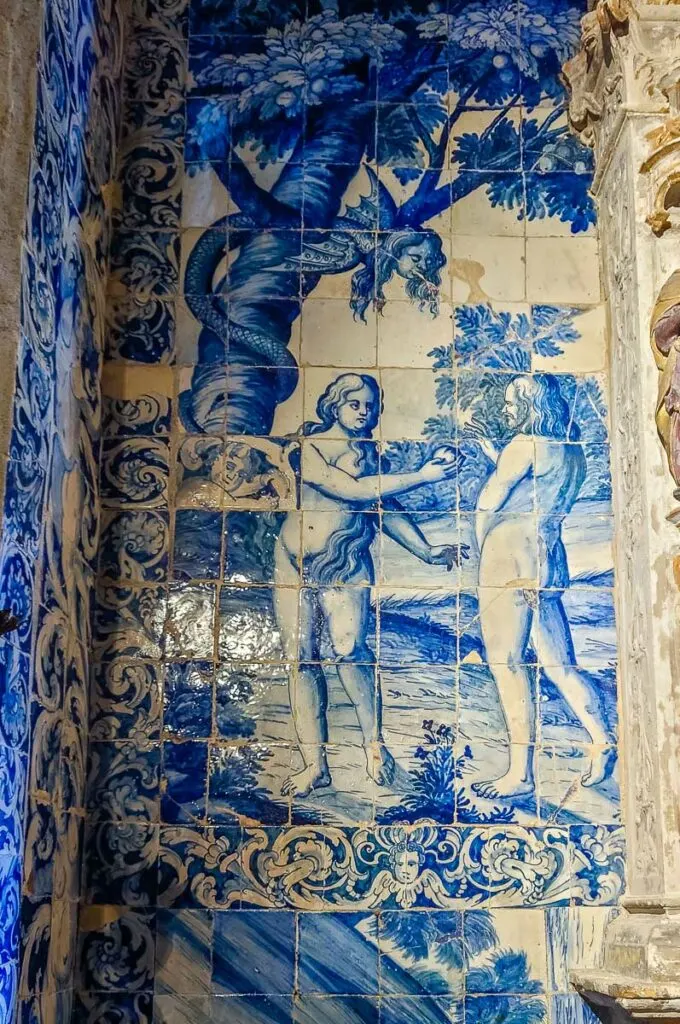
Braga is an ancient city. While its roots may not stretch all the way to Adam and Eve, humans first settled here back in the Megalithic Era. During the Iron Age, the area was dominated by the Bracari – a warlike Celtic tribe.
The ancient Romans arrived in 136 BC. After many battles with the Bracari, they founded the city in 20 BC giving it the name Bracara Augusta. Bracara after their ferocious adversary and Augusta after the then-reigning Roman Emperor Caesar Augustus.
Under Roman dominion, the new city flourished and was even promoted to the capital of the Roman province of Gallaecia (corresponding to modern-day Galicia and parts of Northern Spain and Portugal).
Nowadays, Roman ruins have resurfaced at different points around town. Plus, the locals zealously preserve the distant link with their Roman heritage. Every year, in May, the city of Braga organises a large Roman festival. People dress in Roman tunics, stage historic reenactments, dance, eat, and have fun as the ancient Romans did.
Otherwise, the splendid panel in blue and white that you see above is in the Capela e Casa dos Coimbras – a historic chapel and house in Braga. The walls of the chapel are decorated with azulejo tiles depicting the Creation of the World. It’s one of the best sights to see in the Portuguese Rome.
Apparently, just like Eve, the women of the Bracari tribe were very much masters of their own destiny. According to ancient authors, they fought mercilessly in battles and preferred death to captivity.
3. The Celtic Sun God Smiles in the Courtyard of Braga’s Imposing Cathedral
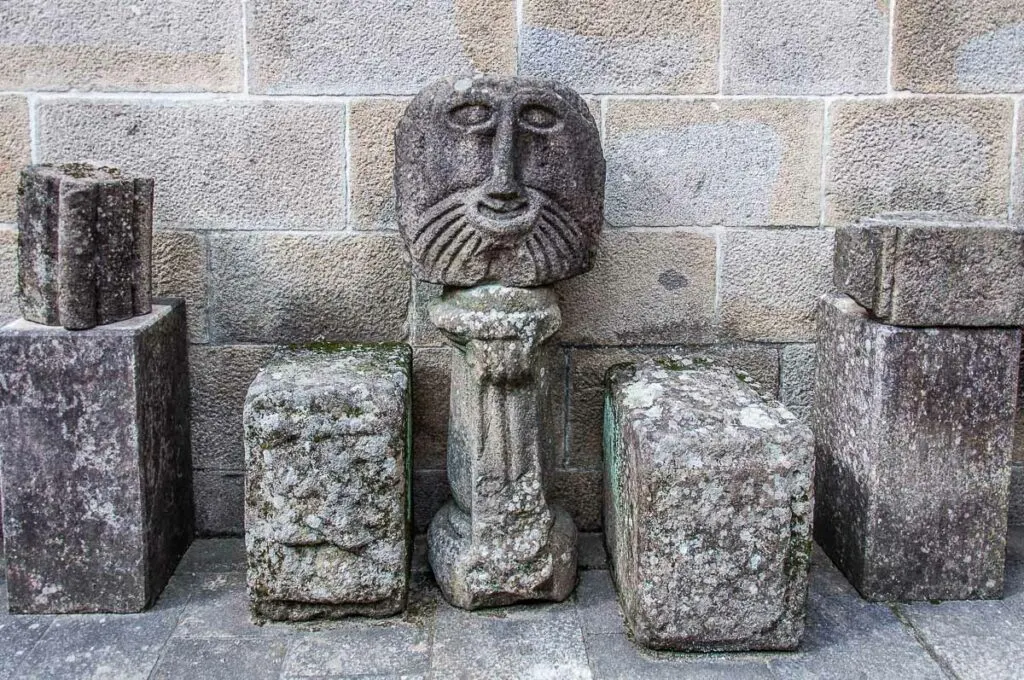
This Celtic idol is about 3,000 years old. It depicts the Sun God. I loved its face – with simple features carved in the stone. In a way, it looked a bit as if drawn by a child’s hand. Yet, it’s so full of character and radiance.
Curiously enough, nowadays, the idol stands in the courtyard of Sé de Braga – the oldest Cathedral in all of Portugal. Its foundation precedes the creation of the country! To this day, Braga is the religious capital of Portugal.
The imposing Cathedral is certainly the top sight to visit in Braga’s historic centre. Its many chapels are lavishly decorated with gilded woodcarvings and azulejo panels. It even has two organs – positioned one opposite the other.
In the Cathedral’s courtyard, archaeological artefacts are lined against the tall stone walls. Fragments of pillars, old capitals, pieces that thousands of years ago were part of something big and important. Among them stands the head of the Sun God. Still smiling!
4. Modern-Day Braga Stands On Top of Roman Ruins
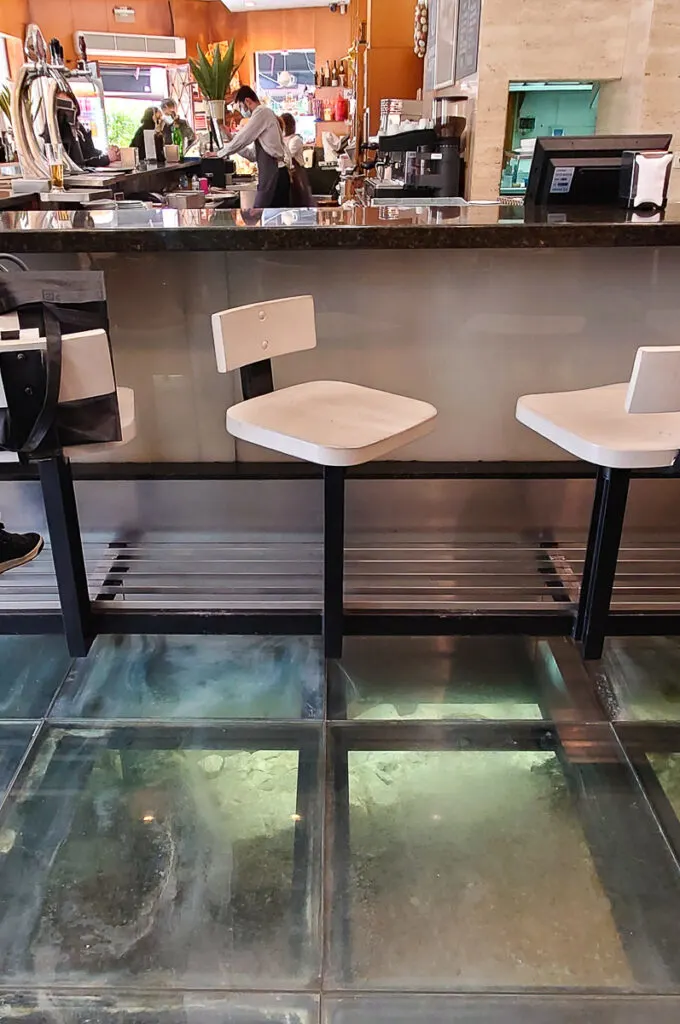
Roman ruins have popped up at many places around Braga. On the edge of the historic centre stand the remains of Roman thermal baths and a Roman theatre. Braga Cathedral is built at the spot where the Roman market and a temple dedicated to Isis had once stood.
The most curious Roman vestiges in Braga for me, though, are the remains of a Roman house – a domus – which have been unearthed underneath a popular cafe in town. Called As Frigideiras do Cantinho, it was founded in 1796 and serves famous local delicacies. Among them are:
- frigideiras – a type of pie made of puff pastry and filled with mince meat; and
- folhados – a pastry with different types of fillings – from fish to meat.
The ruins of the domus were discovered in the cellar of the cafe during renovation works in 1996. It dates to the 3rd-5th centuries AD. At its heyday, the Roman house was large, had a hypocaust, and a private bathroom.
Nowadays, you can stop at the cafe to enjoy a light lunch or a coffee and a pastry. If you sit inside, you will see that the floor has been replaced with a thick glass pane. Through it, you can see the Roman remains. For the full experience, make sure that you order a slice of the cafe’s famous Roman cake.
5. Feast Like a Roman in Braga
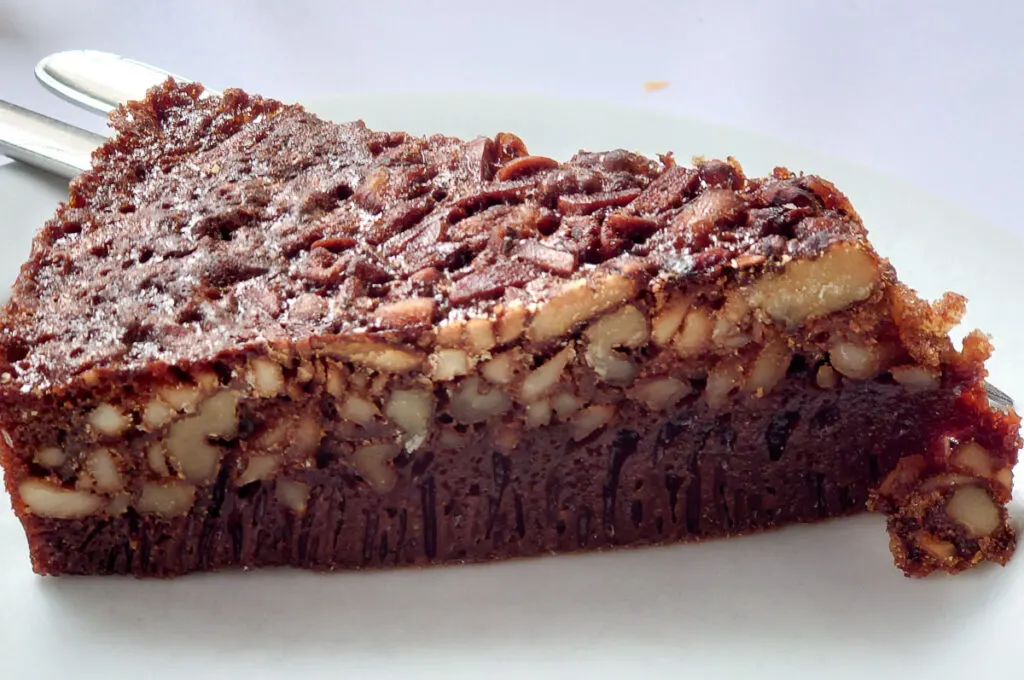
Braga’s Roman cake or bolo romano de Braga in Portuguese is a very unique cake. Its recipe dates back to the 2nd century AD. It comes from the famous Roman cookbook De Re Coquinaria (in English, On the Subject of Cooking). The cake is made with nuts, honey, and milk. For added luxury, a drop or two of port wine is added to the mix, too.
You can only taste this unique cake in As Frigideiras do Cantinho – the small cafe with Roman ruins underneath its glass floor. The owners started making it in limited quantities for the city-wide celebrations on the occasion of 2,000 years since the foundation of Braga by the Romans. Coincidentally, around the same time, the Roman ruins were discovered underneath their counters and tables.
The most interesting thing about Braga’s bolo romano is that it’s baked in a bain-marie in the oven for an hour or so. This is what gives it its unusual consistency.
Before my visit, I had compiled a long list of things to savour in Braga. The Portuguese Rome has several local delicacies – from frigideiras to tibias and pudim do Abade de Priscos – that I really wanted to try. The Roman cake was top of my list on account of its history and recipe.
The first thing that I noticed as the waiter brought me a slice of bolo romano was its compact, glutinous look and feel. Trying to tear a piece off with the fork took some expert manoeuvring. The cake had a dense, slightly chewy texture. It’s definitely not your everyday sponge.
I love a city with culinary history and having a chance to taste something that the ancient Romans ate was a highlight of my visit to beautiful Braga.
More Information:
6. Ancient Symbols Connect Braga’s Present to Its Past
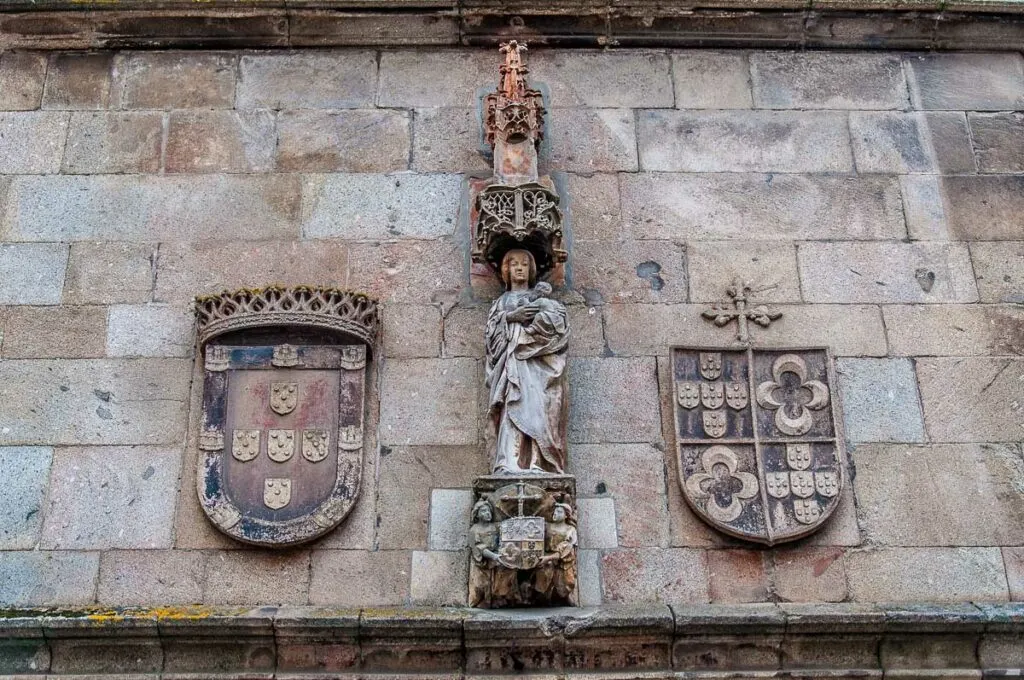
As you walk around Braga’s historic centre, you will glimpse the city’s large Cathedral from many different angles. Several streets lead to it from several sides thus giving you an idea of how big the structure actually is. We first approached the Cathedral walking down a small side street.
The figure of Madonna Lactans – the nursing Virgin Mary pictured above – caught my eye on the darkened external wall. On its other side – I would later find out – is the Cathedral’s high altar. Known as the Nossa Senhora do Leite in Portuguese, the statue is a symbol of fertility and maternity.
It was made in 1519 by Nicolas Chantereine – a French sculptor who also worked on the famous Mosteiro dos Jerónimos in Lisbon. It graced the external wall of Braga Cathedral for many centuries before being placed inside the Cathedral’s museum to preserve its grace and beauty from atmospheric factors. What you see on the outside nowadays is a perfect copy.
Although fairly popular during the Middle Ages, today statues and images of the Nursing Madonna are quite rare in the Catholic world. When I lived in Italy, one of my little personal projects there was to find and photograph as many of them as possible. At the time, I had a baby myself, so they appealed to me on a personal level. While I am not religious, I found them comforting in a world that has made breastfeeding in public such a peculiar subject to broach.
So, I was delighted to come across this statue of the Nursing Madonna in Braga. I found it very elegant and chaste with the drapes of the Virgin Mary’s cloak covering her shoulders, arms, and body. I also found the figure very proud and protective in her stance and in the motherly way she is holding the Infant Jesus.
Curiously enough, two millennia ago, in Braga there was a Roman temple dedicated to Isis – the Egyptian goddess of fertility. It stood either at the same place where Braga Cathedral now stands or nearby. A stone slab with an inscription about the temple was reused during the construction of the Cathedral. Nowadays, it makes part of the lower wall underneath the statue of the Madonna Lactans.
7. The First Diocese on the Iberian Peninsula Was Founded in Braga by an Apostle of Jesus Christ
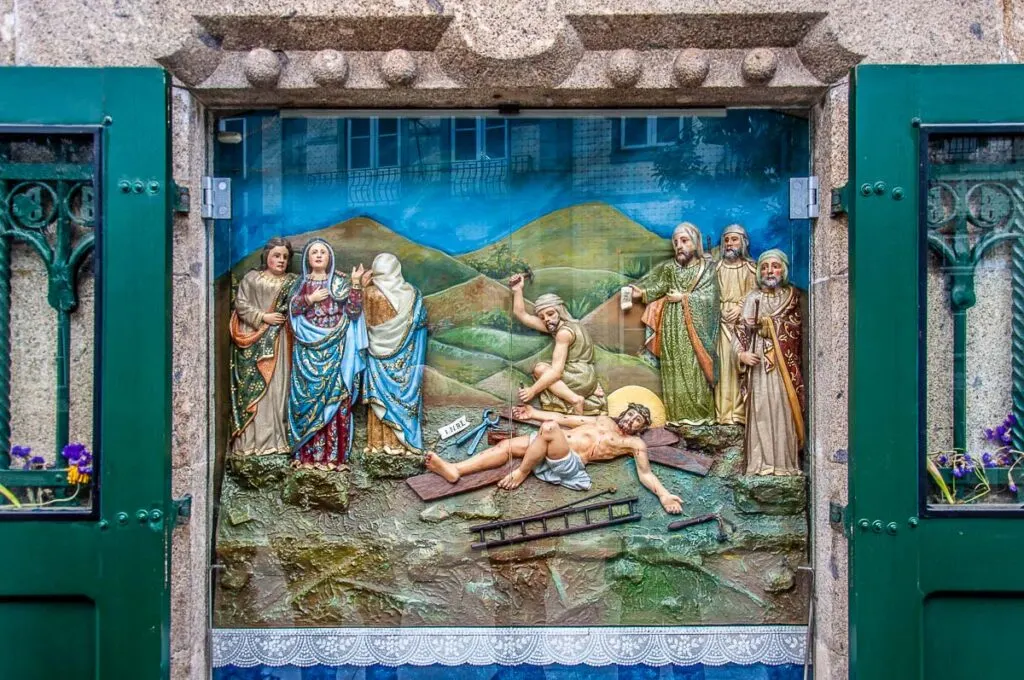
Portugal is a Catholic country and religion is an intrinsic part of its cultural identity. This is particularly true for Braga where the presence of Christianity dates back almost two thousand years.
Nowadays, the city is rich in churches and chapels, holds large religious celebrations, and family life follows the rites of the Catholic Church. In fact, we visited Braga the week before its Easter processions. The historic centre was nicely decorated for the occasion and church doors had huge palm leaves affixed to them in readiness for Palm Sunday.
I spotted the Crucifixion scene pictured above on the wall of the historic Capela e Casa dos Coimbras. Its vivid colours and the rather realistic depiction of Jesus being placed on the Cross made me stop and look at it for a while.
The scene is part of Braga’s Way of the Cross. This is a series of originally 14 small chapels portraying events of the Passion of the Christ. Known as Calvários in Portuguese, nowadays only half of them remain in Braga.
It is believed that Christianity was brought to Braga by a person who would have witnessed the events leading up to the Crucifixion. He was one of Jesus’s first disciples and one of the Twelve Apostles. In English, he is known as St. James the Great. In Spanish, his name is Santiago el Mayor.
Nowadays, he is the Patron Saint of Spain. His relics are in the capital of Galicia – Santiago de Compostela – which is just two hours up the road from Braga.
After the Ascension of Jesus, St. James the Great travelled to the Iberian Peninsula to convert to Christianity the Romans and the local tribes. In 45 AD in Braga, he founded the first diocese in the whole peninsula and selected his disciple St. Peter of Rates to lead it. As the first bishop of Braga, he held office until 60 AD when he was martyred by beheading.
8. The Cathedral of Braga Has a Millennial History and It’s a Must-See
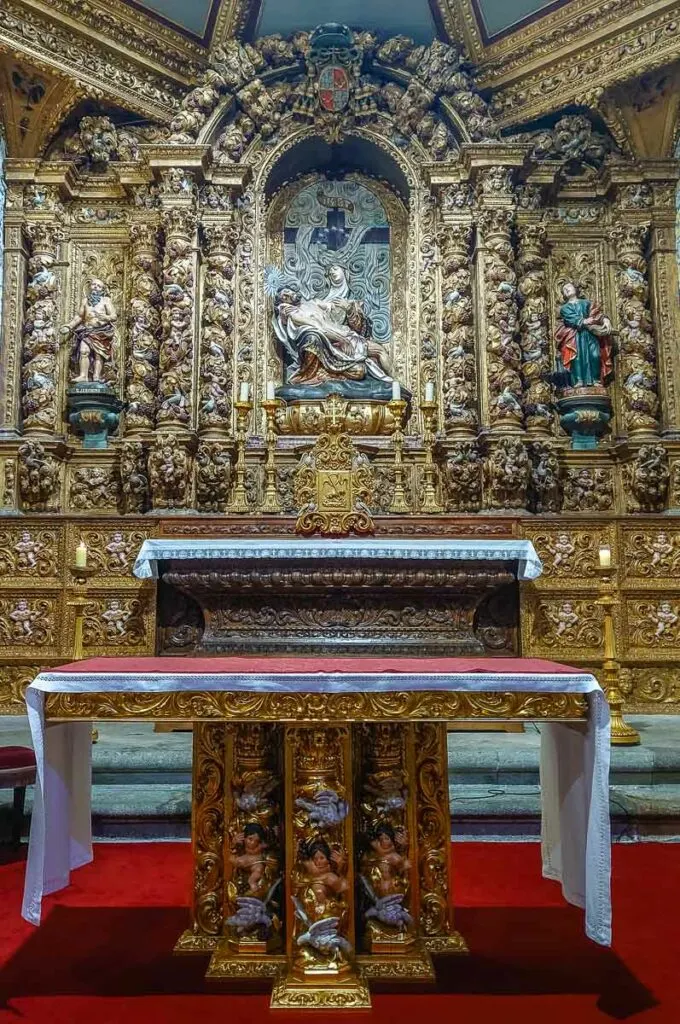
The history of Braga Cathedral stretches back to the first years of the diocese of Braga. As such, it’s considered the Primary Basilica of the Iberian Peninsula and its Archbishop has the title of Primate of the Spains. After the Cardinal-Patriarch of Lisbon, he is the second most important representative of the Catholic Church in Portugal.
Braga Cathedral even has its own liturgy – the so-called Rite of Braga – which has been in use since the 11th century.
The Cathedral was consecrated in 1089 and the construction of its building as we see it today began in the 12th century. Curiously, both precede the foundation of Portugal as a country. After an earthquake affected the first structure, the designs were changed several times. Eventually, it took several hundreds of years for the building works to conclude.
Nowadays, Braga Cathedral has a large and imposing body with different architectural styles – Romanesque, Gothic, and Baroque – reflected in its facade and many chapels. Inside, it keeps a significant collection of religious art and artefacts. Quite unusually, Braga Cathedral also has two organs placed one opposite the other. It’s not surprising then that each year it holds an International Organ Festival.
A must-see when in Braga, the Cathedral is also where many illustrious figures are laid to rest. Among them are the first Bishop of Braga – St. Peter of Rates – as well as the parents of the first Portuguese king.
9. Two Stained Glass Windows Create a Curious Effect in Braga Cathedral
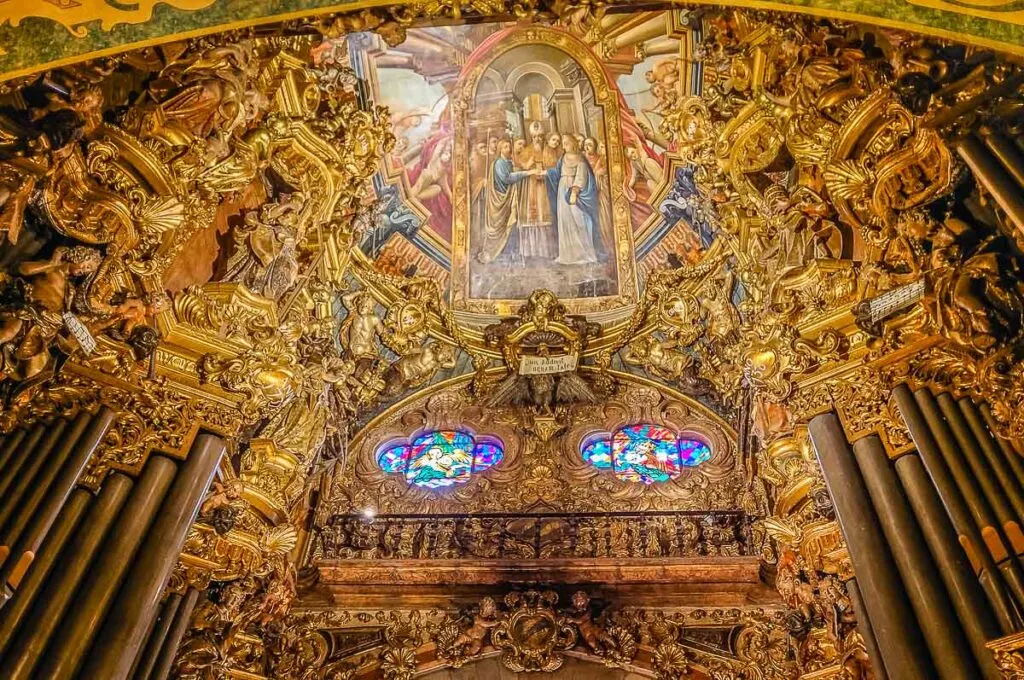
Braga Cathedral is an interesting mixture of Gothic restraint and Baroque opulence. Expect massive stone walls and intricate gilded woodwork, azulejo panels in blue and white and ceilings painted in bright colours.
The detail that made the biggest impression on me was these two small windows covered with stained glass. Their shape, their colours, and the light that was beautifully flowing through them created the illusion – at least for me – of God’s eyes looking into the immense nave of the Cathedral.
There are three trails that you can follow during your visit to Braga Cathedral. I suggest buying the combined ticket which gives you access to all three and at present costs only five euros per person. This will give you a chance, among other things, to see the choir stalls. Beautifully carved and gilded, they are also very close to the two stained glass windows in the picture above.
10. This is Farricoco – a Curious Character You May Come Across in Braga
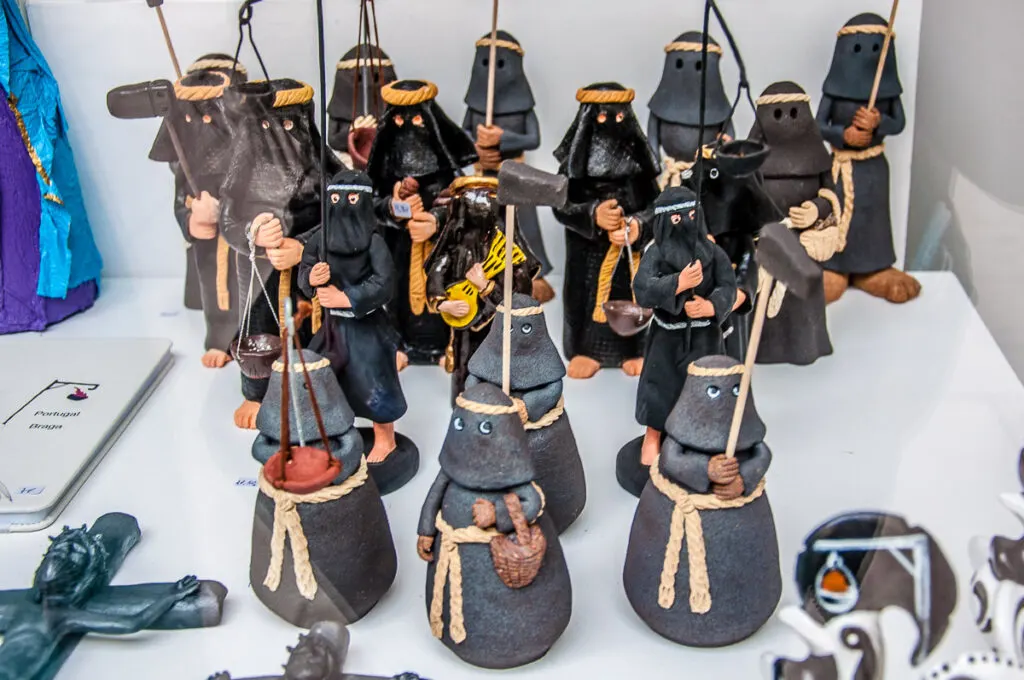
Covered in black from head to toes and with only two holes to look through in his full head covering, this is Farricoco. You may come across a large group of them if you visit Braga during the Holy Week.
As we travelled to the Portuguese Rome in the days before Easter, we didn’t see the actual Farricocos but came across many representations of them all over the city. Small clay figures of this typical for Braga character were adorning window displays. By the entrance door of the souvenir shop of Braga Cathedral, there was even a full-size mannequin dressed as a Farricoco.
Always curious to find out a tidbit or two about a place I am visiting, I asked a lady in one of the sights we popped in what this strange figure represented. Her answer was that a Farricoco was a sinner who had repented. During the traditional Easter procession, he would wear a full black covering so as not to be recognised. In his hands, he would carry an old-fashioned clapper to make noise.
On the website of Braga’s Holy Week, I found a slightly different interpretation of the traditions behind Farricoco. You can see the full description here (it’s in Portuguese). In a nutshell, it says that the Farricocos in pagan times were a group of masked people who would run up and down the streets announcing the passing of the condemned prisoners and announcing their crimes.
Later on, this pagan tradition was absorbed into the Christian customs of the land. So, the Farricocos began to roam the streets and call for those sinners who had repented and had been absolved to be reintegrated into the church. Nowadays, they are part of the traditional Holy Week procession in Braga.
The clappers they use are a substitute for the ringing of the churches’ bells as these have to remain silent on certain days of the Holy Week.
11. Tall Facades Flank the Streets in the Historic Centre of Braga
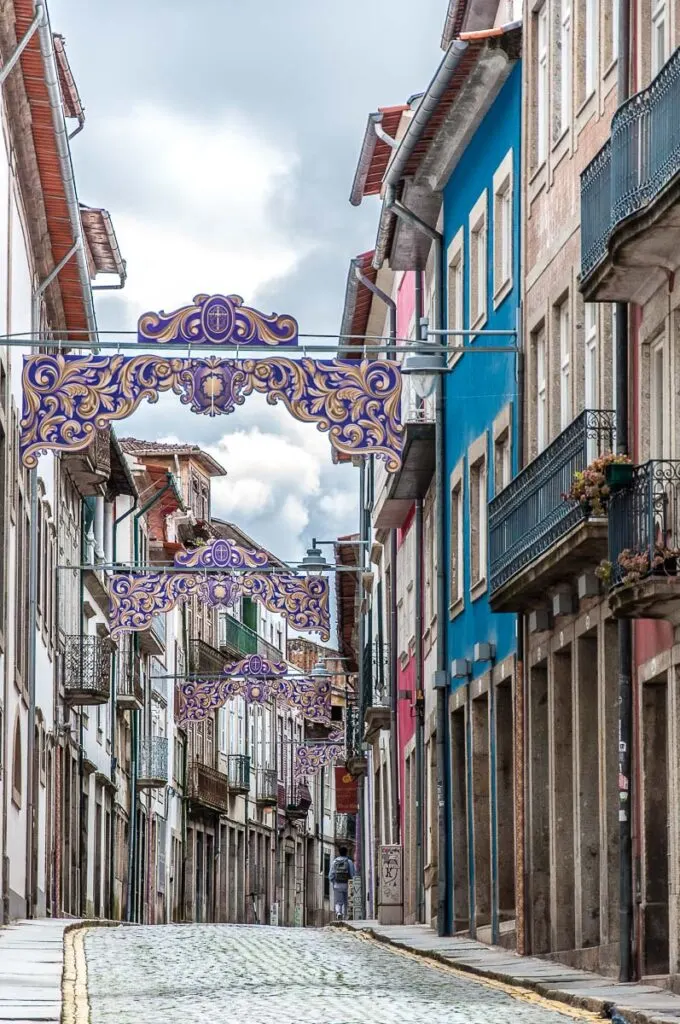
Braga’s historic centre is crisscrossed by dozens of streets and alleys. Although not quite maze-like, they turn and curve creating a lot of visual interest as you explore the city. You never quite know what is it that you are going to come across behind the next corner.
It could be a pretty little square lined up with blooming trees, a centuries-old palace or a glimpse of the imposing Cathedral.
Walking around the historic centre of Braga, what I enjoyed seeing the most were the facades of the tall buildings that flank the streets here. Often covered with azulejos – the tin-glazed tiles typical for Portugal – their jewel colours and high- or low-relief patterns add greatly to the beauty of the city.
Here is one such curving street leading away from Braga’s historic centre. Aren’t the lines – both super straight and elegantly wavy – that are created by the sequence of tall residential buildings simply gorgeous?!
12. My Favourite View in Braga Is Glimpsed From the Small Window of a Hidden Tower
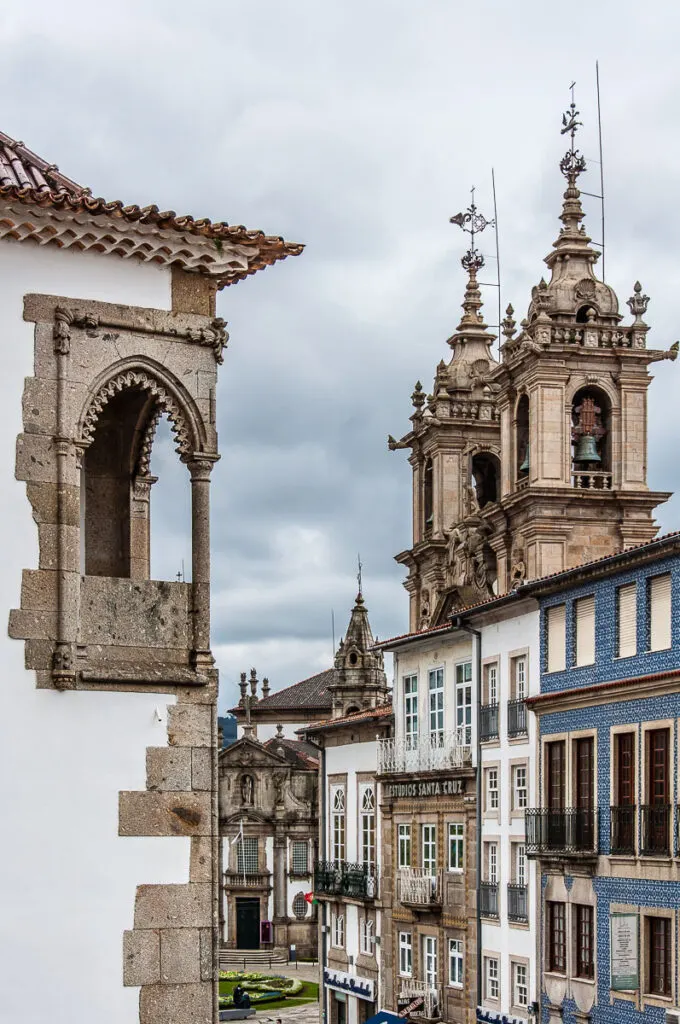
This is my favourite view in Braga in Portugal. The beautifully ornamented corner balcony of the historic house Casa dos Coimbras overlooks a long line of facades. The scene is dominated by the twin bell towers of the Holy Cross Church – Igreja de Santa Cruz.
This view revealed itself to me from a narrow window at the top of a small tower. Very much hidden from view, the tower is attached to the back of the chapel known as Capela dos Coimbras. Both the chapel and the house create one of the most interesting sights in Braga.
To be perfectly honest, I wasn’t planning to visit either during our day trip to the Portuguese Rome. There were already dozens of other must-sees on my sightseeing list and time was short, very short. Yet, as we were walking past the chapel and seeing it sitting so pretty on the side of a small square, I had this very strong desire to get to know it better.
Although tiny, the chapel was very beautiful and richly decorated. Its small space offered plenty of things to see – from large azulejo panels depicting the Fall of Adam and Eve (which I mentioned under point 2 above) to a sunken floor covering old tombs.
Then, at the back of the chapel stood its small tower. We scaled its spiral staircase to a small plain room at the top. Along the way, I came across the small narrow opening in the centuries-old wall, looked through it, and fell in love with the view outside.
I loved the many straight lines – both running parallel to one another and juxtaposed. It created a visual harmony that was beautiful to take in.
13. In Braga You Can Enjoy the Typical for Portugal Manueline Style
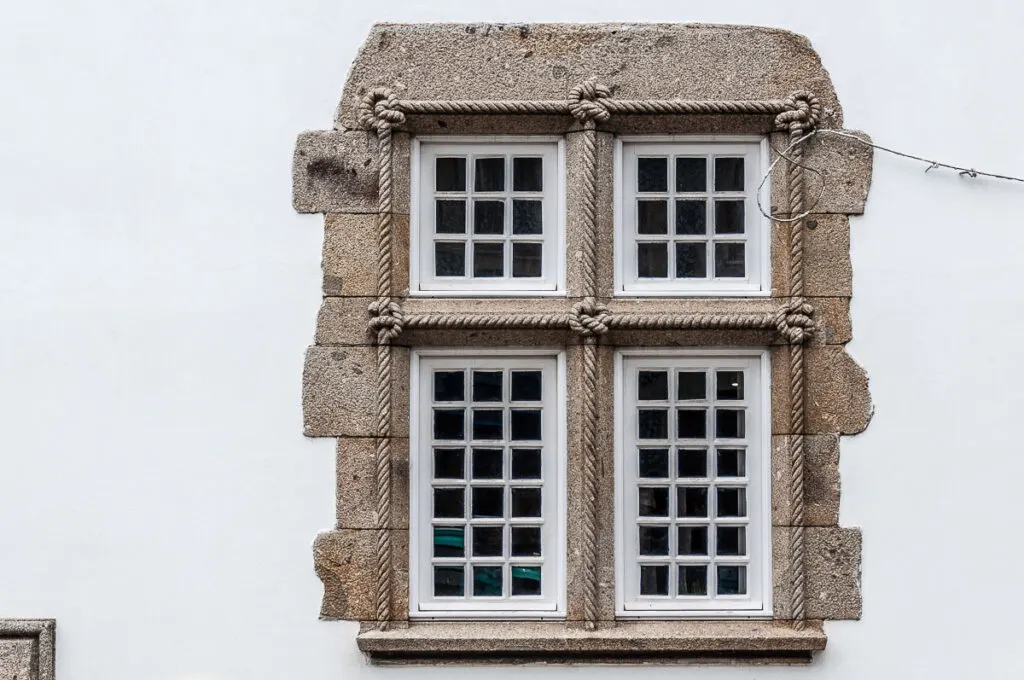
Why is this window frame decorated with a knotted rope?! It’s a bit unusual, don’t you think?!
Curiously enough, knotted or interlaced rope is one of Portugal’s most used ornamental elements. Its roots are in the so-called Estilo Manuelino or Manueline style. This is a late-Gothic/early Renaissance style named after the Portuguese King Manuel. During his reign from 1495 to 1521, the country’s seafaring expeditions led to the discovery and exploration of many new for Europe lands.
As a result, elements referencing both seafaring and newly discovered territories were adopted into the architectural and artistic language of the period. Expect spherical astrolabes, corals, algae, pinecones, sirens, and different plants, plus lots and lots of ropes.
In Braga, I loved seeing the Manueline windows of the above-mentioned Casa dos Coimbras. This is one of them. The others are more richly decorated with florid motifs but I liked the simplicity of this one the most.
Curiously enough, while the Manueline windows and doors of the Casa dos Coimbras are original, the actual house is not. Built in the 16th century, it was demolished in 1906 to open space for Braga’s improved urban plan. The original Manueline elements were preserved though and used in the reconstruction of the house at a spot just a bit further away from where it had once stood.
14. The Fountain of the Castles Is Topped by a Female Figure Representing the City of Braga
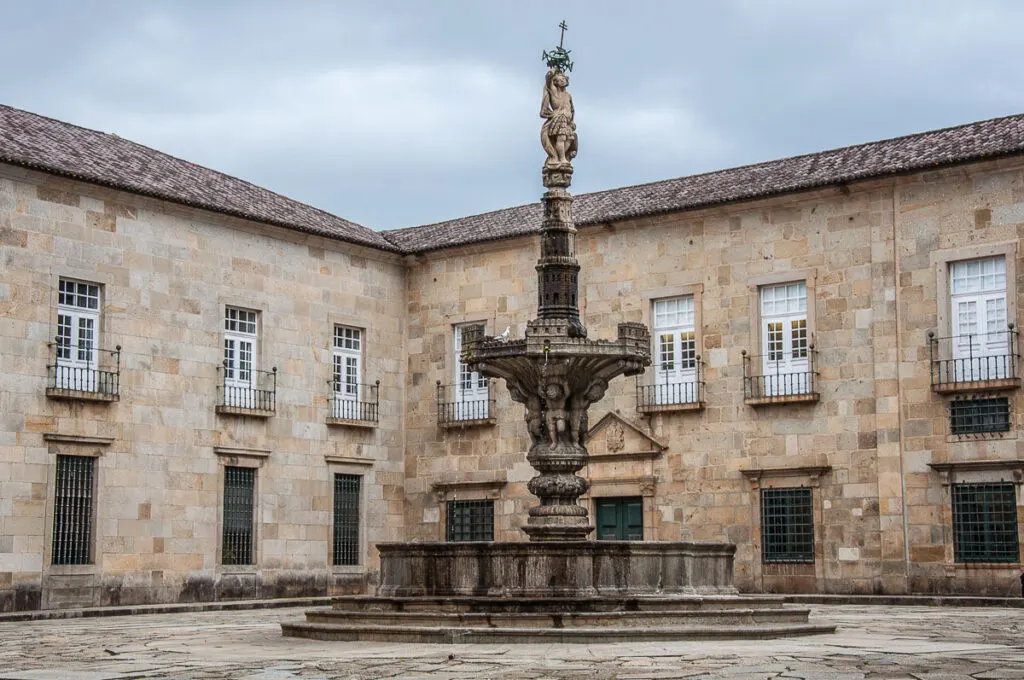
This is the Chafariz dos Castelos or the Fountain of the Castles in English. Chafariz is one of my favourite Portuguese words. There is something both so funny and satisfying saying it out loud.
Otherwise, the fountain dates back to 1723 and you will find it gracing a small square in the heart of the historic centre. It’s crowned by a female figure which, they say, represents the city of Braga.
The fountain owes its name to the six small castles that circle the small platform in the middle of its central pillar. A spout protrudes from the base of each castle splashing water in the large basin at the bottom.
As you walk around Braga, you will come across the Chafariz dos Castelos just a few steps up the street from the Cathedral. The small square is covered with stone slabs and flanked on three sides by a severe-looking building.
In the past, this was the Archbishop’s Palace. Nowadays, it hosts the offices of the University of Minho, the local archive, and the city’s library.
15. Braga Has One of the Most Beautiful Urban Gardens in Europe
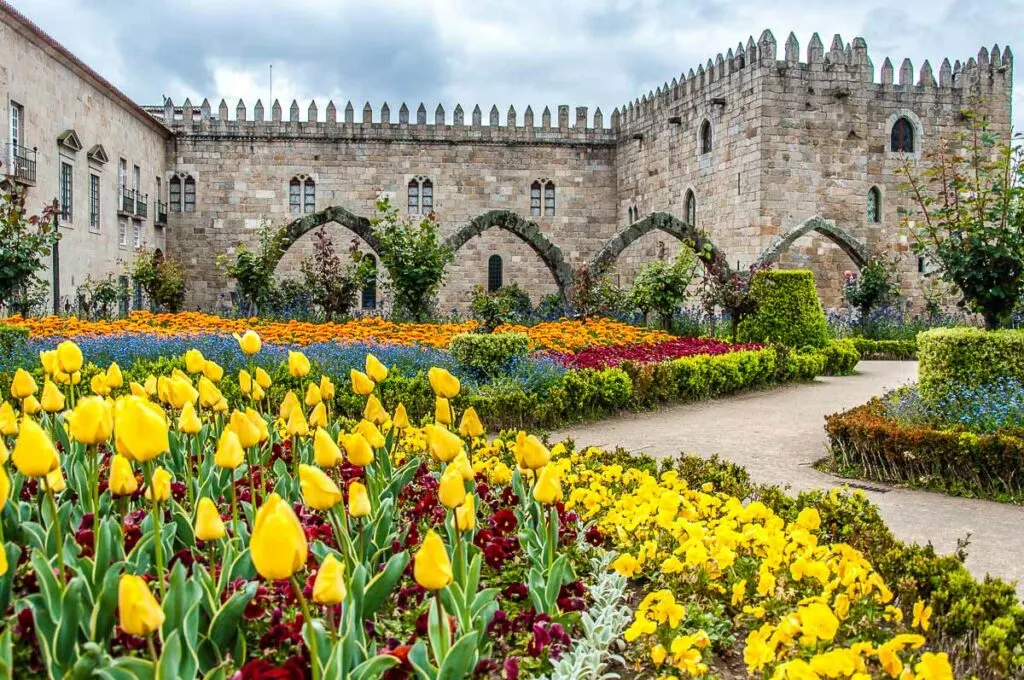
Braga’s Jardim de Santa Bárbara is a riot of seasonal blooms and colours. As we had the chance to see it in spring, we found a tapestry of flowers that were perfectly colour-coordinated. Yellows followed by oranges followed by reds followed by purples… It was simply extraordinary!
The tulips were the obvious stars with their large perfect cups towering over thick clusters of pansies.
You will find this lovely urban garden at the back of Braga’s former Archbishop’s Palace. In fact, the arcade you can see in the background of the photo above once was part of the medieval building of the palace.
A large fountain decorated with a statue of St. Barbara stands in the midst of the garden. It dates back to the 17th century. Originally, it was part of the Convento dos Remédios – a former monastery that stood about 500 m away from the garden. Nowadays, its place is taken by the city’s Theatro Circo.
The garden is surrounded by a large variety of buildings – from historic facades to an enormous block of offices and flats with shops on the ground floor. For the best views, face the medieval arcade, sit on a small stone bench, and enjoy a few relaxing moments in Braga, Portugal.
16. Braga’s Gateway Without a Gate Allegedly Inspired a Cheeky Portuguese Saying
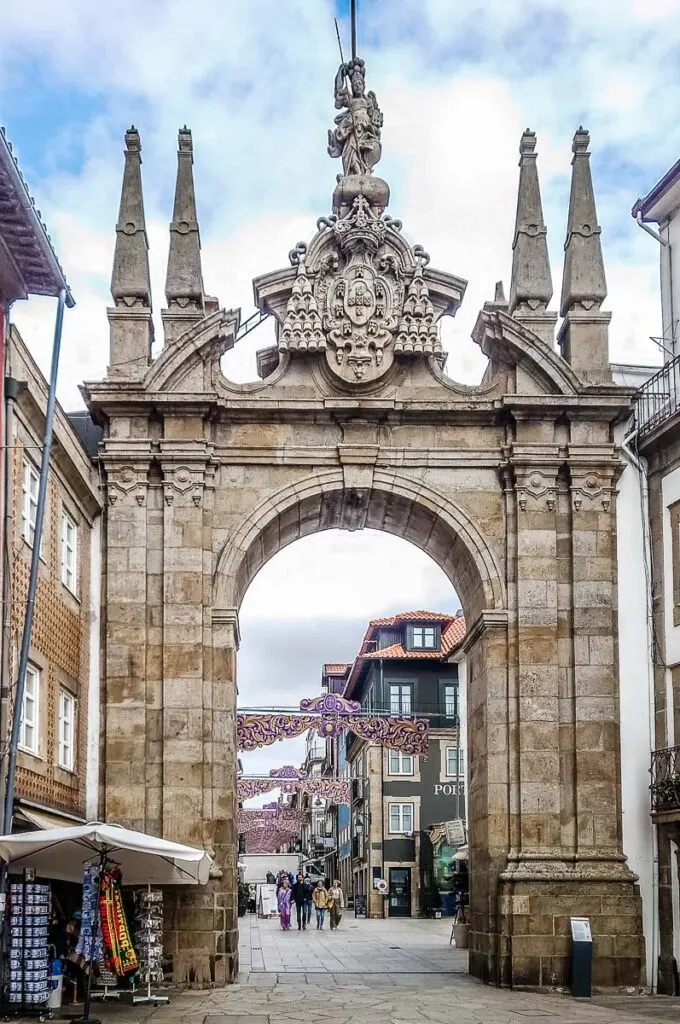
This is Braga’s Arco da Porta Nova or Arch of the New Gate in English. It was first erected in 1512 and unlike the other gateways in Braga’s medieval defensive wall, this one never had a gate installed in it.
At the time, Braga’s population had increased and houses were starting to be built outside of the walls. Plus, the stable political and social situation in 16th-century Portugal negated the need to have an urban nucleus protected by an enclosed wall. So, a gate would have been redundant anyway.
Having a gateway without a gate, allegedly, gave rise to the popular Portuguese saying ‘És de Braga?’ (in English, ‘Are you from Braga?’). It’s traditionally addressed to those who enter a room without shutting the door behind them.
The Arco da Porta Nova is one of the first sights you will see in Braga when you walk from the nearby train station into the historic centre. The gateway, as it is nowadays, actually, dates back to 1772. This is when the original arch was refashioned to suit the then-new architectural styles. A figure symbolising the city of Braga crowns the imposing structure.
17. If You Only Do One Thing in Braga in Portugal, Make Sure You Eat the Famous Tibias
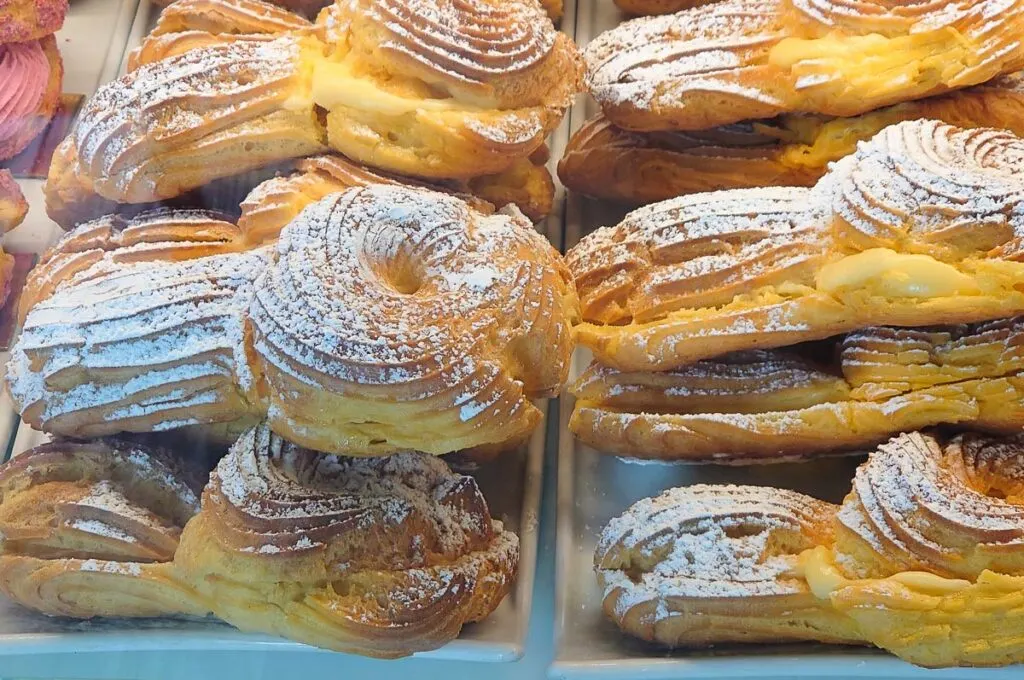
If you walk through the Arco da Porta Nova, you will find yourself on Rua de Dom Diogo de Sousa – one of the main streets in the city of Braga. The Cathedral and the former Archbishop’s Palace are a short walk away in a straight line.
Most importantly, if you stop for a second right before walking through the arch and look to your left, you will see the best place in town to enjoy the local delicacy – tibias de Braga.
An elegant cafe on the ground floor of a large building covered with blue azulejo tiles makes the best tibias in Braga and quite fittingly is called Tibias de Braga itself. No matter how pressed you may be for time you just have to stop and have a tibia or two. Or as many as you like. They are delicious!
The tibias de Braga are a type of eclair. They have a very delicate crispy texture. While eclairs are often a bit chewy and difficult to take a bite off, the tibias de Braga melt in the mouth. The sensation is elevated by the silky creme patisserie they are traditionally filled with.
In shape, the tibias de Braga look like a shinbone or tibia – the larger of the two bones in the lower leg. However, if you have a wilder imagination, they also may remind you of a completely different anatomical part.
The Tibias de Braga cafe by Arco da Porta Nova makes both traditional and new varieties of this dessert. I particularly loved their caramel version.
More Information:
18. This Baroque Stairway Has 573 Steps. It Must Be the Most Famous Stairway in the Whole of Portugal
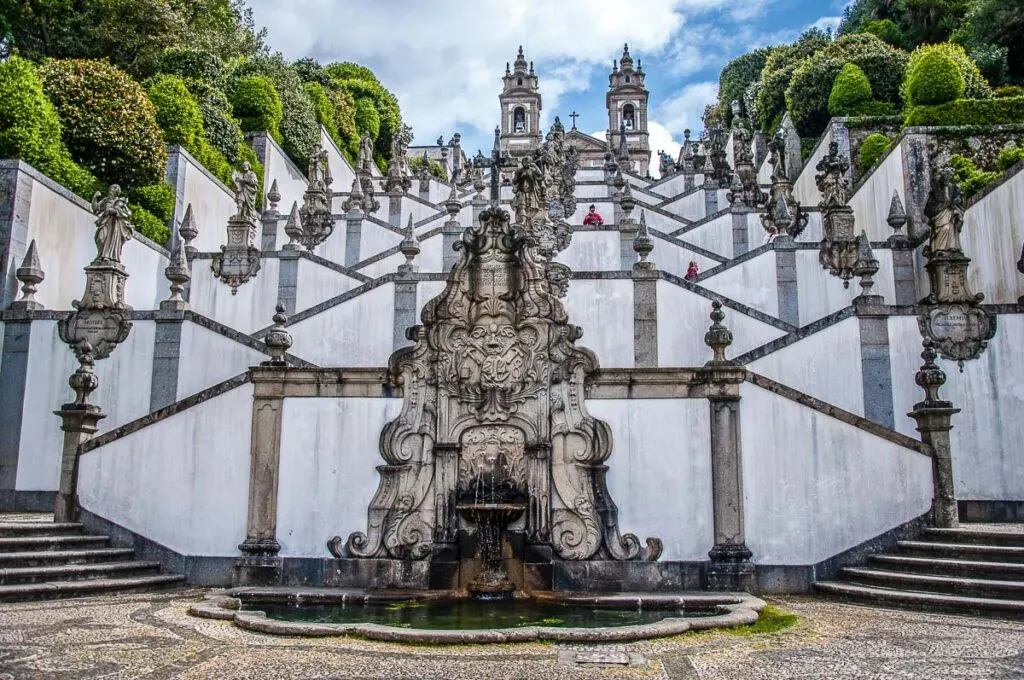
A visit to Braga must include a stop at the Sanctuary of Bom Jesus do Monte, too. With a centuries-old history and inscribed as a UNESCO World Heritage Site, it consists of a hilltop church with a splendid stairway of 573 steps.
The stairway has a curious story and an inspired Baroque design. Built in stages between 1723 and 1837, its whitewashed walls create striking perspective views.
Its lower part is known as the Stairway of the Portico and has 376 steps. The upper part is split into the Stairway of the Five Senses with 104 steps and the Stairway of the Three Virtues with 93 steps. Fountains, allegorical statues, chapels, and many different details build a visual story that the pilgrims absorb as they climb up the slope, ideally, on their knees.
Bom Jesus do Monte was one of the two main things I originally wanted to see during my trip to Braga in Portugal. The other one was the city’s Cathedral. The sanctuary is about 25 minutes away by bus from Braga’s train station. Click on the link below for details on how to visit and explore this iconic place in Northern Portugal for yourself.
More Information:
19. And This is the World’s Oldest Water-Powered Funicular
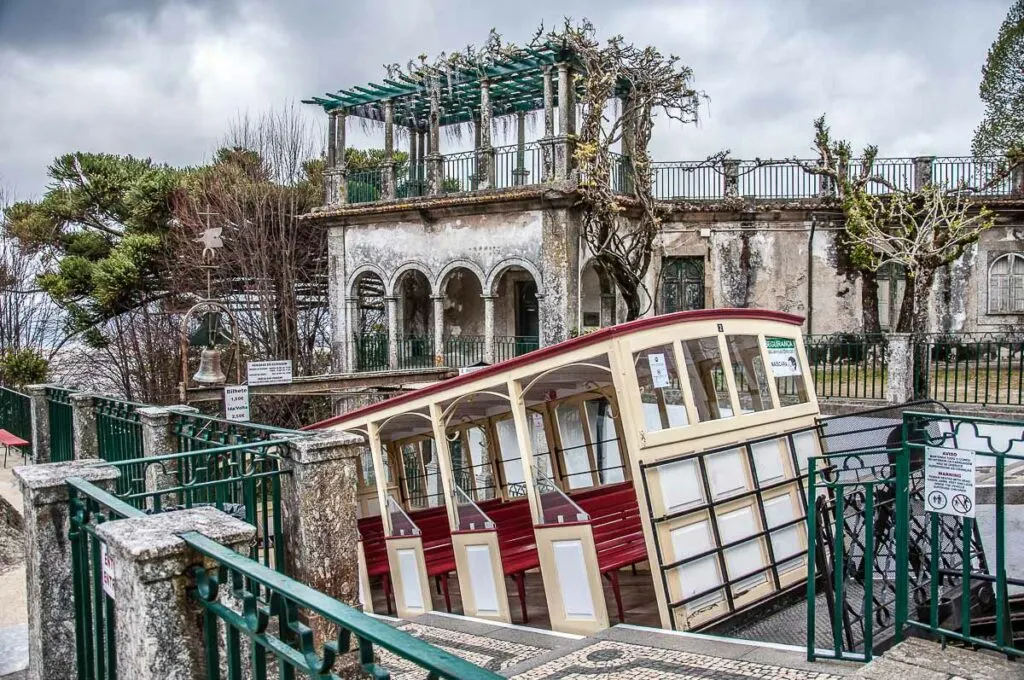
Each year, thousands of people travel from all over the world to visit the Sanctuary of Bom Jesus do Monte near Braga in Northern Portugal. Its splendid staircase is the magnet that attracts them to it. It’s designed as a spiritual and physical pilgrimage up the face of the steep hill.
Yet, most people nowadays (myself included, I admit) see the stairway on the way down instead of on the way up. To save time and effort, they take this cute little funicular all the way to the top of the hill.
Now, I must say that this is not just any old funicular. It’s in fact, the world’s oldest designed to move thanks to the power of water. It’s been in operation since 25th March 1882. So, you could say that riding it is akin to a one-in-a-life experience from a historic and engineering point of view. You simply have to do it. There is no other way!
The funicular takes about three minutes to reach the hilltop along a track that is around 300 m long. It only runs twice an hour, though. So, make sure that you plan your arrival time accordingly. Click on the link below for further details.
More Information:
20. There Are Two Churches in This Photo. One You Can See. The Other You Can’t
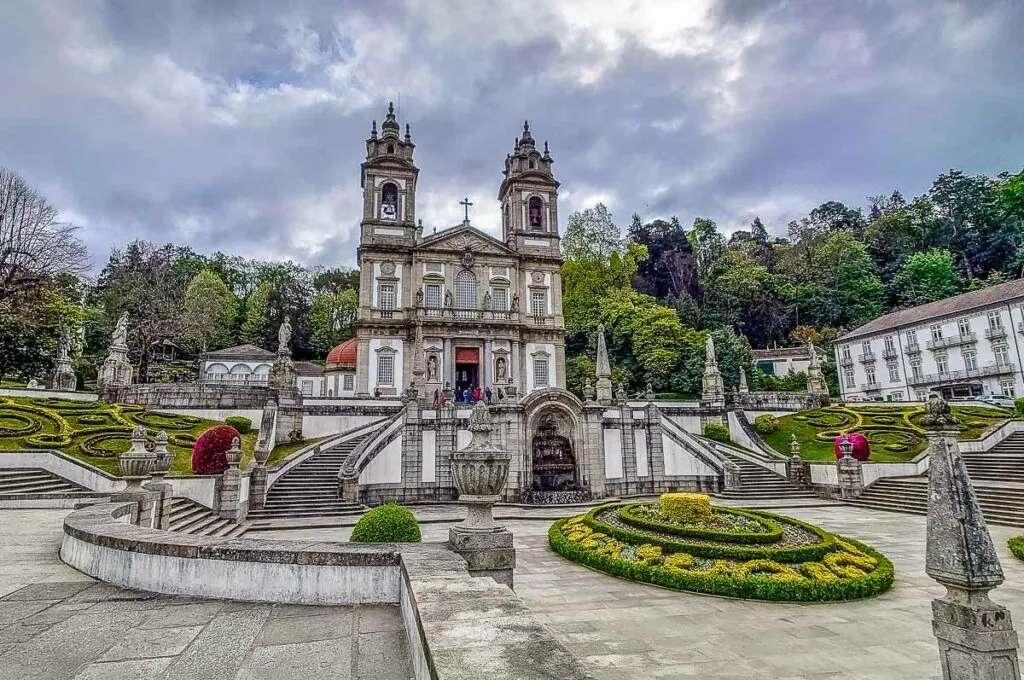
This is what you see when you reach the top of the hill on which the church of the Sanctuary of Bom Jesus do Monte stands. It’s very beautiful, isn’t it?!
Now, there is one curious thing about this view. It features the imposing Neoclassical basilica which they say is the most photographed church in Portugal. As you can see, there is a large open space in front of it.
Today, this space is beautifully landscaped and has a nice fountain topped by the small figure of a pelican. In the past, however, this was the place where the original church of the Sanctuary stood. It was built between 1722-1723.
Only six decades later, the church could no longer accommodate the ever-increasing numbers of pilgrims visiting the sanctuary. It had also suffered significant structural damage.
So, a decision was taken to demolish it and the construction of the hilltop basilica as we see it nowadays began. Designed by the Portuguese architect Carlos Amarante, the church has strong Italian influences and is one of the first Neoclassical buildings in the country. It was completed in 1811 and consecrated in 1834.
More Information:
21. Let’s Finish This Photowalk of Braga in Portugal with a Relaxing Boat Trip
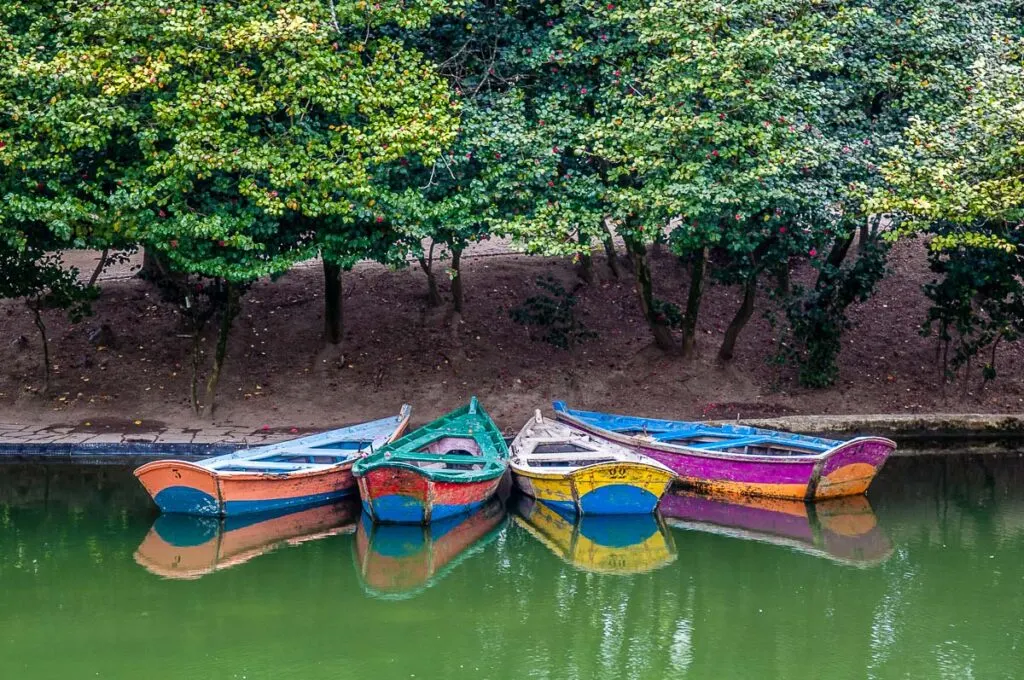
A large lush park stretches behind the Neoclassical basilica of the Sanctuary of Bom Jesus do Monte near the city of Braga in Portugal. A small pond surrounded by tall trees stands right in its heart. Here colourful handmade boats can be rented for a relaxing row on the water.
What a great way to finish a visit to Braga with all that the Portuguese Rome has to offer.
More Information:
In Conclusion
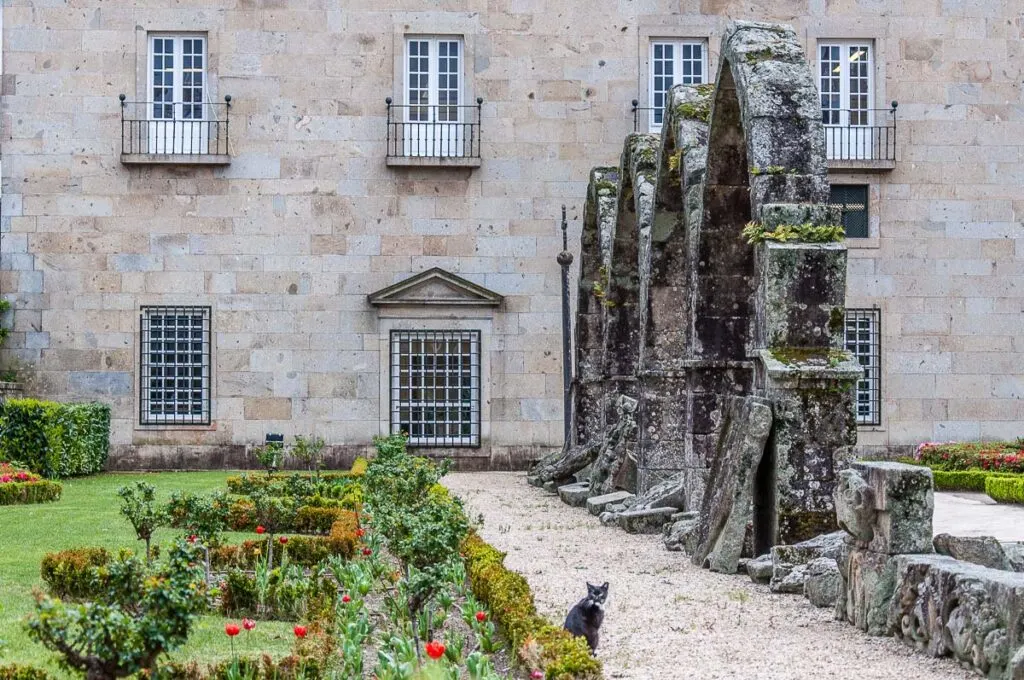
I hope that you enjoyed this walk in pictures through the sights of Braga – the city known as the Portuguese Rome on account of its millennial history and religious sights.
An easy distance away from Porto – Portugal’s second-largest city – Braga is a great destination for a day trip or a longer holiday in the north of the country. From dozens of churches and archaeological artefacts to vibrant events and delicious desserts, the city has a lot to offer if you are looking for an exciting and enriching destination to visit just off the beaten track.
If you enjoy visual travel guides, have a look at the following blog posts, too:
- Virtual Travel Guide to Aveiro, Portugal – 18 Photos to Entice You to Visit the Portuguese Venice
- Visual Travel Guide to Guimarães – 17 Photos That Will Make You Want to Visit the City That Birthed Portugal
- 63 Photos of Porto That Capture the Character of Portugal’s Second-Largest City – A Visual Travel Guide
Otherwise, have a wonderful time getting to know Braga and its beautiful corners and sights!
Enjoy your holiday in Portugal!
Now, get ready quick for your trip to Braga in Portugal!
- Consult these guidebooks.
- Buy plane tickets.
- Book train tickets, bus tickets or rent a car.
- Research accommodation.
- Select local tours and activities.
More Helpful Travel Info for You
Best of Portugal: One Day in Aveiro, Photos of Aveiro, One Day in Porto, Photos of Porto, One Day in Guimarães, Photos of Guimarães, Sanctuary of Bom Jesus do Monte, The Best Portuguese Desserts and Pastries
Best of Italy: Venice, Lake Garda, Veneto, Lombardy, Emilia-Romagna, Marche, Friuli Venezia Giulia, Trentino, Italy with Kids, Italy for Foodies, Day Trips in Italy, Hiking in Italy, Christmas in Italy
Best of England: London, Kent, Dorset, East Sussex, Days Out in England
Travel: Travel Resources, The Joy of Travel, Safety Tips
Thank you for reading! Please, leave me a comment, pin the images or use the buttons right at the top and at the end of this blog post to share it on social media.
For more useful information like this, please, like my blog’s page on Facebook and subscribe to my strictly no-spam newsletter.
Pin This Blog Post!
